Atten Babler Corn & Soybeans FX Indices – Jun…
Corn FX Indices:
The Atten Babler Commodities Corn Foreign Exchange (FX) Indices remained at or near record high levels during May ’15. The USD/Corn Importer FX Index increased to a new record high while the USD/Domestic Corn Importer FX Index increased slightly to the second highest figure on record. The USD/Corn Exporter FX Index fell for the second consecutive month but remains at the fourth highest figure on record.
Global Corn Net Trade:
Major net corn exporters are led by the U.S., followed by Brazil, Ukraine, Argentina, Russia and India (represented in green in the chart below). Major net corn importers are led by Japan, followed by the EU-28, South Korea, Mexico and Egypt (represented in red in the chart below).
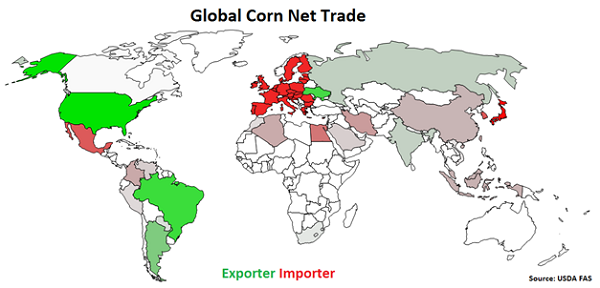 USD/Corn Exporter FX Index:
The USD/Corn Exporter FX Index declined 4.4 points in May ’15 to a value of 257.2 as the Ukrainian hryvnia continues to strengthen against the USD. The USD/Corn Exporter FX Index remains at the fourth highest figure on record and has increased 77.6 points since the beginning of 2014 and 32.0 points throughout the past six months. A strengthening USD/Corn Exporter FX Index reduces the competitiveness of U.S. corn relative to other exporting regions, ultimately resulting in less foreign demand, all other factors being equal. USD appreciation against the Ukrainian hryvnia and Argentine peso has accounted for the majority of the gains since the beginning of 2014, despite the Ukrainian hryvnia strengthening against the USD over the past three months.
USD/Corn Exporter FX Index:
The USD/Corn Exporter FX Index declined 4.4 points in May ’15 to a value of 257.2 as the Ukrainian hryvnia continues to strengthen against the USD. The USD/Corn Exporter FX Index remains at the fourth highest figure on record and has increased 77.6 points since the beginning of 2014 and 32.0 points throughout the past six months. A strengthening USD/Corn Exporter FX Index reduces the competitiveness of U.S. corn relative to other exporting regions, ultimately resulting in less foreign demand, all other factors being equal. USD appreciation against the Ukrainian hryvnia and Argentine peso has accounted for the majority of the gains since the beginning of 2014, despite the Ukrainian hryvnia strengthening against the USD over the past three months.
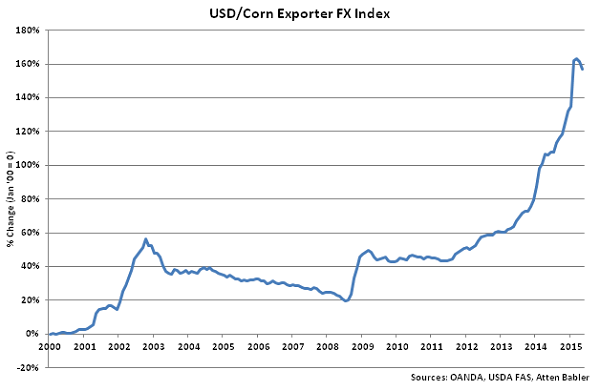 USD/Corn Importer FX Index:
The USD/Corn Importer FX Index increased 0.6 points in May ’15 to a new high value of 224.2. The USD/Corn Importer FX Index has increased 25.2 points since the beginning of 2014 and 13.4 points throughout the past six months. A strengthening USD/Corn Importer FX Index results in less purchasing power for major corn importing countries, making U.S. corn more expensive to import. USD appreciation against the Iranian rial and euro has accounted for the majority of the gains since the beginning of 2014.
USD/Corn Importer FX Index:
The USD/Corn Importer FX Index increased 0.6 points in May ’15 to a new high value of 224.2. The USD/Corn Importer FX Index has increased 25.2 points since the beginning of 2014 and 13.4 points throughout the past six months. A strengthening USD/Corn Importer FX Index results in less purchasing power for major corn importing countries, making U.S. corn more expensive to import. USD appreciation against the Iranian rial and euro has accounted for the majority of the gains since the beginning of 2014.
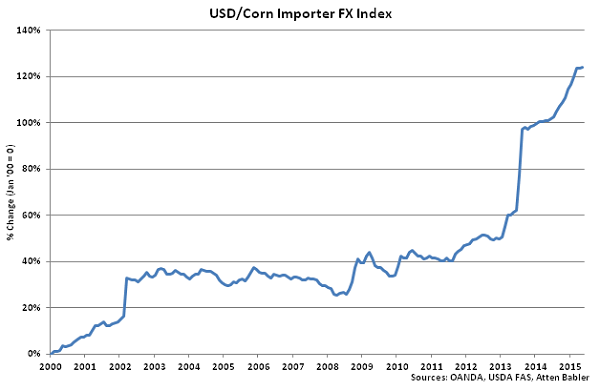 U.S. Corn Export Destinations:
Major destinations for U.S. corn are led by Japan, followed by Mexico, South Korea, Columbia, Egypt and China.
U.S. Corn Export Destinations:
Major destinations for U.S. corn are led by Japan, followed by Mexico, South Korea, Columbia, Egypt and China.
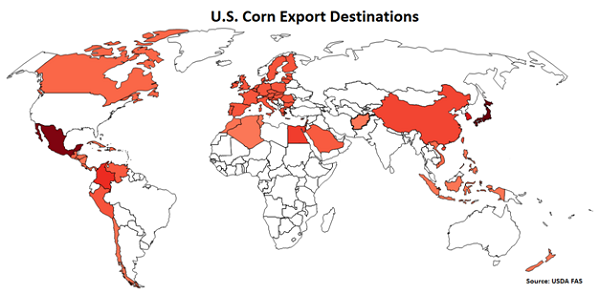 USD/Domestic Corn Importer FX Index:
The USD/Domestic Corn Importer FX Index increased 0.1 points in May ’15 a value of 147.1, the second highest figure on record. The USD/Domestic Corn Importer FX Index has increased 14.9 points since the beginning of 2014 and 8.2 points throughout the past six months. A strengthening USD/Domestic Corn Importer FX Index results in less purchasing power for the traditional buyers of U.S. corn, ultimately resulting in less foreign demand, all other factors being equal. USD appreciation against the Mexican peso and Japanese yen has accounted for the majority of the gains since the beginning of 2014.
USD/Domestic Corn Importer FX Index:
The USD/Domestic Corn Importer FX Index increased 0.1 points in May ’15 a value of 147.1, the second highest figure on record. The USD/Domestic Corn Importer FX Index has increased 14.9 points since the beginning of 2014 and 8.2 points throughout the past six months. A strengthening USD/Domestic Corn Importer FX Index results in less purchasing power for the traditional buyers of U.S. corn, ultimately resulting in less foreign demand, all other factors being equal. USD appreciation against the Mexican peso and Japanese yen has accounted for the majority of the gains since the beginning of 2014.
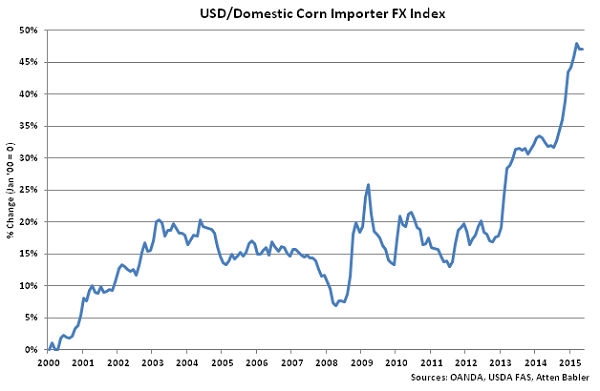 Soybeans FX Indices:
The U.S. dollar (USD) remained at elevated levels within the Atten Babler Commodities Soybeans Foreign Exchange (FX) Indices during May ’15. The USD/Soybeans Exporter FX Index increased slightly to the second highest figure on record while slight declines were experienced within the USD/Soybeans Importer FX Index and USD/Domestic Soybeans Importer FX Index. Despite the declines, the USD/Soybeans Importer FX Index and USD/Domestic Soybeans Importer FX Index both remain at the fourth highest figures experienced in the past seven and a half years.
Global Soybeans Net Trade:
Major net soybeans exporters are led by Brazil, followed by the U.S., Argentina, Paraguay and Uruguay (represented in green in the chart below). Major net soybeans importers are led by China, followed by the EU-28, Mexico, Japan and Taiwan (represented in red in the chart below).
Soybeans FX Indices:
The U.S. dollar (USD) remained at elevated levels within the Atten Babler Commodities Soybeans Foreign Exchange (FX) Indices during May ’15. The USD/Soybeans Exporter FX Index increased slightly to the second highest figure on record while slight declines were experienced within the USD/Soybeans Importer FX Index and USD/Domestic Soybeans Importer FX Index. Despite the declines, the USD/Soybeans Importer FX Index and USD/Domestic Soybeans Importer FX Index both remain at the fourth highest figures experienced in the past seven and a half years.
Global Soybeans Net Trade:
Major net soybeans exporters are led by Brazil, followed by the U.S., Argentina, Paraguay and Uruguay (represented in green in the chart below). Major net soybeans importers are led by China, followed by the EU-28, Mexico, Japan and Taiwan (represented in red in the chart below).
 USD/Soybeans Exporter FX Index:
The USD/Soybeans Exporter FX Index increased 0.7 points in May ’15 to a value of 189.6, the second highest figure on record. The USD/ Soybeans Exporter FX Index has increased 37.3 points since the beginning of 2014 and 16.3 points throughout the past six months. A strengthening USD/Soybeans Exporter FX Index reduces the competitiveness of U.S. soybeans relative to other exporting regions, ultimately resulting in less foreign demand, all other factors being equal. USD appreciation against the Argentine peso and Brazilian real has accounted for the majority of the gains since the beginning of 2014.
USD/Soybeans Exporter FX Index:
The USD/Soybeans Exporter FX Index increased 0.7 points in May ’15 to a value of 189.6, the second highest figure on record. The USD/ Soybeans Exporter FX Index has increased 37.3 points since the beginning of 2014 and 16.3 points throughout the past six months. A strengthening USD/Soybeans Exporter FX Index reduces the competitiveness of U.S. soybeans relative to other exporting regions, ultimately resulting in less foreign demand, all other factors being equal. USD appreciation against the Argentine peso and Brazilian real has accounted for the majority of the gains since the beginning of 2014.
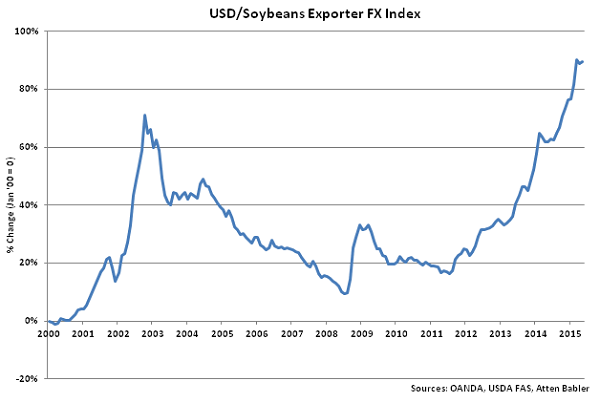 USD/Soybeans Importer FX Index:
The USD/Soybeans Importer FX Index declined 0.5 points in May ’15 to a value of 95.1. The USD/ Soybeans Importer FX Index remains at the fourth highest figure experienced in the past seven and a half years and has increased 6.7 points since the beginning of 2014 and 3.5 points throughout the past six months. A strengthening USD/Soybeans Importer FX Index results in less purchasing power for major soybeans importing countries, making U.S. soybeans more expensive to import. USD appreciation against the euro and Turkish lira has accounted for the majority of the gains since the beginning of 2014, despite both currencies gaining against the USD in May ’15.
USD/Soybeans Importer FX Index:
The USD/Soybeans Importer FX Index declined 0.5 points in May ’15 to a value of 95.1. The USD/ Soybeans Importer FX Index remains at the fourth highest figure experienced in the past seven and a half years and has increased 6.7 points since the beginning of 2014 and 3.5 points throughout the past six months. A strengthening USD/Soybeans Importer FX Index results in less purchasing power for major soybeans importing countries, making U.S. soybeans more expensive to import. USD appreciation against the euro and Turkish lira has accounted for the majority of the gains since the beginning of 2014, despite both currencies gaining against the USD in May ’15.
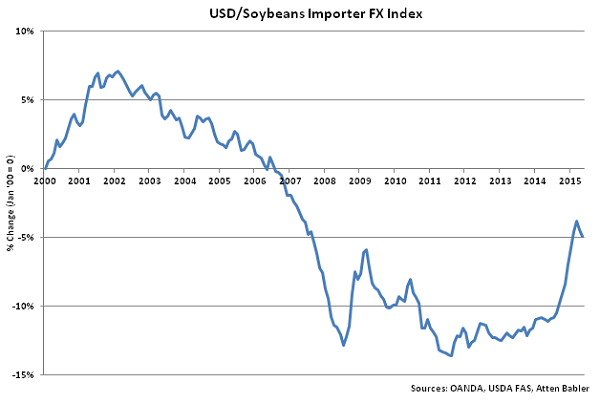 U.S. Soybeans Export Destinations:
Major destinations for U.S. soybeans are led by China, followed by Mexico, Indonesia, Japan, Germany and Taiwan.
U.S. Soybeans Export Destinations:
Major destinations for U.S. soybeans are led by China, followed by Mexico, Indonesia, Japan, Germany and Taiwan.
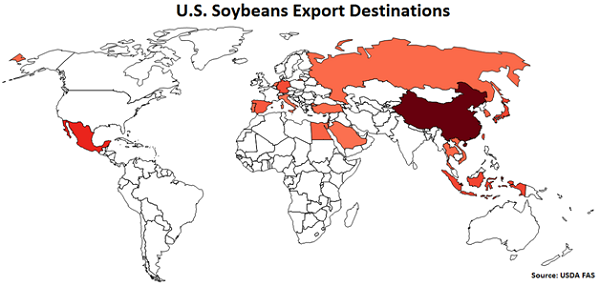 USD/Domestic Soybeans Importer FX Index:
The USD/Domestic Soybeans Importer FX Index declined 0.2 points in May ’15 to a value of 97.9. The USD/ Domestic Soybeans Importer FX Index remains at the fourth highest figure experienced in the past seven and a half years and has increased 6.5 points since the beginning of 2014 and 3.6 points throughout the past six months. A strengthening USD/Domestic Soybeans Importer FX Index results in less purchasing power for the traditional buyers of U.S. soybeans, ultimately resulting in less foreign demand, all other factors being equal. USD appreciation against the Mexican peso, Turkish lira and Japanese yen has accounted for the majority of the gains since the beginning of 2014.
USD/Domestic Soybeans Importer FX Index:
The USD/Domestic Soybeans Importer FX Index declined 0.2 points in May ’15 to a value of 97.9. The USD/ Domestic Soybeans Importer FX Index remains at the fourth highest figure experienced in the past seven and a half years and has increased 6.5 points since the beginning of 2014 and 3.6 points throughout the past six months. A strengthening USD/Domestic Soybeans Importer FX Index results in less purchasing power for the traditional buyers of U.S. soybeans, ultimately resulting in less foreign demand, all other factors being equal. USD appreciation against the Mexican peso, Turkish lira and Japanese yen has accounted for the majority of the gains since the beginning of 2014.
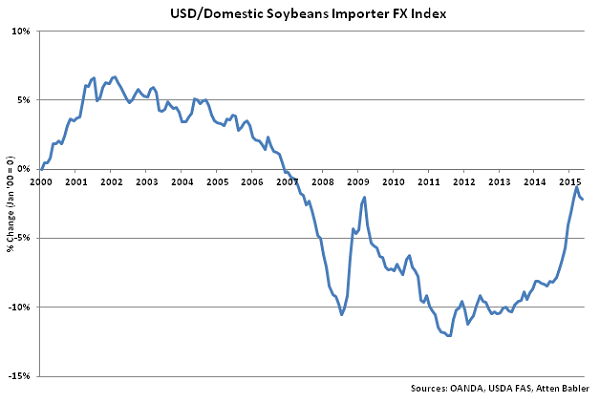
 USD/Corn Exporter FX Index:
The USD/Corn Exporter FX Index declined 4.4 points in May ’15 to a value of 257.2 as the Ukrainian hryvnia continues to strengthen against the USD. The USD/Corn Exporter FX Index remains at the fourth highest figure on record and has increased 77.6 points since the beginning of 2014 and 32.0 points throughout the past six months. A strengthening USD/Corn Exporter FX Index reduces the competitiveness of U.S. corn relative to other exporting regions, ultimately resulting in less foreign demand, all other factors being equal. USD appreciation against the Ukrainian hryvnia and Argentine peso has accounted for the majority of the gains since the beginning of 2014, despite the Ukrainian hryvnia strengthening against the USD over the past three months.
USD/Corn Exporter FX Index:
The USD/Corn Exporter FX Index declined 4.4 points in May ’15 to a value of 257.2 as the Ukrainian hryvnia continues to strengthen against the USD. The USD/Corn Exporter FX Index remains at the fourth highest figure on record and has increased 77.6 points since the beginning of 2014 and 32.0 points throughout the past six months. A strengthening USD/Corn Exporter FX Index reduces the competitiveness of U.S. corn relative to other exporting regions, ultimately resulting in less foreign demand, all other factors being equal. USD appreciation against the Ukrainian hryvnia and Argentine peso has accounted for the majority of the gains since the beginning of 2014, despite the Ukrainian hryvnia strengthening against the USD over the past three months.
 USD/Corn Importer FX Index:
The USD/Corn Importer FX Index increased 0.6 points in May ’15 to a new high value of 224.2. The USD/Corn Importer FX Index has increased 25.2 points since the beginning of 2014 and 13.4 points throughout the past six months. A strengthening USD/Corn Importer FX Index results in less purchasing power for major corn importing countries, making U.S. corn more expensive to import. USD appreciation against the Iranian rial and euro has accounted for the majority of the gains since the beginning of 2014.
USD/Corn Importer FX Index:
The USD/Corn Importer FX Index increased 0.6 points in May ’15 to a new high value of 224.2. The USD/Corn Importer FX Index has increased 25.2 points since the beginning of 2014 and 13.4 points throughout the past six months. A strengthening USD/Corn Importer FX Index results in less purchasing power for major corn importing countries, making U.S. corn more expensive to import. USD appreciation against the Iranian rial and euro has accounted for the majority of the gains since the beginning of 2014.
 U.S. Corn Export Destinations:
Major destinations for U.S. corn are led by Japan, followed by Mexico, South Korea, Columbia, Egypt and China.
U.S. Corn Export Destinations:
Major destinations for U.S. corn are led by Japan, followed by Mexico, South Korea, Columbia, Egypt and China.
 USD/Domestic Corn Importer FX Index:
The USD/Domestic Corn Importer FX Index increased 0.1 points in May ’15 a value of 147.1, the second highest figure on record. The USD/Domestic Corn Importer FX Index has increased 14.9 points since the beginning of 2014 and 8.2 points throughout the past six months. A strengthening USD/Domestic Corn Importer FX Index results in less purchasing power for the traditional buyers of U.S. corn, ultimately resulting in less foreign demand, all other factors being equal. USD appreciation against the Mexican peso and Japanese yen has accounted for the majority of the gains since the beginning of 2014.
USD/Domestic Corn Importer FX Index:
The USD/Domestic Corn Importer FX Index increased 0.1 points in May ’15 a value of 147.1, the second highest figure on record. The USD/Domestic Corn Importer FX Index has increased 14.9 points since the beginning of 2014 and 8.2 points throughout the past six months. A strengthening USD/Domestic Corn Importer FX Index results in less purchasing power for the traditional buyers of U.S. corn, ultimately resulting in less foreign demand, all other factors being equal. USD appreciation against the Mexican peso and Japanese yen has accounted for the majority of the gains since the beginning of 2014.
 Soybeans FX Indices:
The U.S. dollar (USD) remained at elevated levels within the Atten Babler Commodities Soybeans Foreign Exchange (FX) Indices during May ’15. The USD/Soybeans Exporter FX Index increased slightly to the second highest figure on record while slight declines were experienced within the USD/Soybeans Importer FX Index and USD/Domestic Soybeans Importer FX Index. Despite the declines, the USD/Soybeans Importer FX Index and USD/Domestic Soybeans Importer FX Index both remain at the fourth highest figures experienced in the past seven and a half years.
Global Soybeans Net Trade:
Major net soybeans exporters are led by Brazil, followed by the U.S., Argentina, Paraguay and Uruguay (represented in green in the chart below). Major net soybeans importers are led by China, followed by the EU-28, Mexico, Japan and Taiwan (represented in red in the chart below).
Soybeans FX Indices:
The U.S. dollar (USD) remained at elevated levels within the Atten Babler Commodities Soybeans Foreign Exchange (FX) Indices during May ’15. The USD/Soybeans Exporter FX Index increased slightly to the second highest figure on record while slight declines were experienced within the USD/Soybeans Importer FX Index and USD/Domestic Soybeans Importer FX Index. Despite the declines, the USD/Soybeans Importer FX Index and USD/Domestic Soybeans Importer FX Index both remain at the fourth highest figures experienced in the past seven and a half years.
Global Soybeans Net Trade:
Major net soybeans exporters are led by Brazil, followed by the U.S., Argentina, Paraguay and Uruguay (represented in green in the chart below). Major net soybeans importers are led by China, followed by the EU-28, Mexico, Japan and Taiwan (represented in red in the chart below).
 USD/Soybeans Exporter FX Index:
The USD/Soybeans Exporter FX Index increased 0.7 points in May ’15 to a value of 189.6, the second highest figure on record. The USD/ Soybeans Exporter FX Index has increased 37.3 points since the beginning of 2014 and 16.3 points throughout the past six months. A strengthening USD/Soybeans Exporter FX Index reduces the competitiveness of U.S. soybeans relative to other exporting regions, ultimately resulting in less foreign demand, all other factors being equal. USD appreciation against the Argentine peso and Brazilian real has accounted for the majority of the gains since the beginning of 2014.
USD/Soybeans Exporter FX Index:
The USD/Soybeans Exporter FX Index increased 0.7 points in May ’15 to a value of 189.6, the second highest figure on record. The USD/ Soybeans Exporter FX Index has increased 37.3 points since the beginning of 2014 and 16.3 points throughout the past six months. A strengthening USD/Soybeans Exporter FX Index reduces the competitiveness of U.S. soybeans relative to other exporting regions, ultimately resulting in less foreign demand, all other factors being equal. USD appreciation against the Argentine peso and Brazilian real has accounted for the majority of the gains since the beginning of 2014.
 USD/Soybeans Importer FX Index:
The USD/Soybeans Importer FX Index declined 0.5 points in May ’15 to a value of 95.1. The USD/ Soybeans Importer FX Index remains at the fourth highest figure experienced in the past seven and a half years and has increased 6.7 points since the beginning of 2014 and 3.5 points throughout the past six months. A strengthening USD/Soybeans Importer FX Index results in less purchasing power for major soybeans importing countries, making U.S. soybeans more expensive to import. USD appreciation against the euro and Turkish lira has accounted for the majority of the gains since the beginning of 2014, despite both currencies gaining against the USD in May ’15.
USD/Soybeans Importer FX Index:
The USD/Soybeans Importer FX Index declined 0.5 points in May ’15 to a value of 95.1. The USD/ Soybeans Importer FX Index remains at the fourth highest figure experienced in the past seven and a half years and has increased 6.7 points since the beginning of 2014 and 3.5 points throughout the past six months. A strengthening USD/Soybeans Importer FX Index results in less purchasing power for major soybeans importing countries, making U.S. soybeans more expensive to import. USD appreciation against the euro and Turkish lira has accounted for the majority of the gains since the beginning of 2014, despite both currencies gaining against the USD in May ’15.
 U.S. Soybeans Export Destinations:
Major destinations for U.S. soybeans are led by China, followed by Mexico, Indonesia, Japan, Germany and Taiwan.
U.S. Soybeans Export Destinations:
Major destinations for U.S. soybeans are led by China, followed by Mexico, Indonesia, Japan, Germany and Taiwan.
 USD/Domestic Soybeans Importer FX Index:
The USD/Domestic Soybeans Importer FX Index declined 0.2 points in May ’15 to a value of 97.9. The USD/ Domestic Soybeans Importer FX Index remains at the fourth highest figure experienced in the past seven and a half years and has increased 6.5 points since the beginning of 2014 and 3.6 points throughout the past six months. A strengthening USD/Domestic Soybeans Importer FX Index results in less purchasing power for the traditional buyers of U.S. soybeans, ultimately resulting in less foreign demand, all other factors being equal. USD appreciation against the Mexican peso, Turkish lira and Japanese yen has accounted for the majority of the gains since the beginning of 2014.
USD/Domestic Soybeans Importer FX Index:
The USD/Domestic Soybeans Importer FX Index declined 0.2 points in May ’15 to a value of 97.9. The USD/ Domestic Soybeans Importer FX Index remains at the fourth highest figure experienced in the past seven and a half years and has increased 6.5 points since the beginning of 2014 and 3.6 points throughout the past six months. A strengthening USD/Domestic Soybeans Importer FX Index results in less purchasing power for the traditional buyers of U.S. soybeans, ultimately resulting in less foreign demand, all other factors being equal. USD appreciation against the Mexican peso, Turkish lira and Japanese yen has accounted for the majority of the gains since the beginning of 2014.
